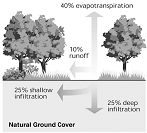Water: Middle School
Exercise III. Calculating Runoff from a Rainstorm
Finding the Fate of a Raindrop
As you discovered in Exercise I, not all rainfall becomes runoff. Draw a diagram below and label all the different things that could happen to a raindrop as it falls to the earth.
What About Volume?
You live in a 120-acre watershed in southeastern Pennsylvania. In a rainfall event, it is common for 3.5 inches of rain to fall in a 24-hour period. Approximately one-third of the water that falls is intercepted by leaves or collects in surface puddles and ponds and evaporates.
Rainfall Volume
The volume of rainfall in a watershed is calculated in acre-inches and is found by the equation:
rainfall volume =
acres in watershed
x inches of rain
1. Calculate the total volume of rain that would fall in the watershed.
2. How much water from the rainfall event remains after the water in leaves, puddles, and ponds evaporates?
3. Assume the watershed is 40 percent permeable. That means that 40 percent of the rain that reaches the ground (after evaporation) will soak into the ground. What is the volume of rain that permeates the ground?
4. What is the volume of runoff? (Hint: If you add this answer to the answer in number 3, you will get the answer to number 2.)
Incoming Urbanization
 |
 |
 |
 |
5. New construction is taking place in your watershed, and half of all the permeable space is now paved over with concrete, an impervious surface. Since your watershed now has only half the permeable land it once had, how much runoff would there be now? (Hint: The original amount of water that reaches the ground after evaporation doesn't change.)

6. How much more runoff is there after construction?
Middle Schools | Streams in the City | Exercises: I | II | III | IV |
